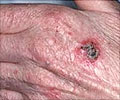- Actinic keratosis - (http://www.nlm.nih.gov/medlineplus/ency/article/000827.htm)
- About Actinic keratosis - (https://www.mayoclinic.org/diseases-conditions/actinic-keratosis/symptoms-causes/syc-20354969)
- Actinic keratosis - Wikipedia - (https://en.wikipedia.org/wiki/actinic_keratosis)
- Actinic Keratosis - Overview - (https://www.skincancer.org/skin-cancer-information/actinic-keratosis/)
About
Actinic Keratosis or Solar Keratosis is a pre-cancerous condition characterized by thick, rough, dry and scaly or crusty patches caused due to long, perennial exposure to sun.
The patches or lesions are more commonly seen in fair-skinned and old people and people who are often exposed to sun for long period. Actinic keratosis is caused due to solar damage, hence also called as Solar Keratosis.

The lesions or patches can be 2 mm to 3cm in size and can be tan, pink, red or brown or a mixture of all these colors. Keratosis patches are typically harmless, however are often itchy and look ugly. Untreated lesions are at a risk of turning malignant and developing into squamous cell carcinoma.
These patches may typically appear on the sun-exposed area, such as the face, ears, neck, scalp, back of hands, forearms, elbows, or even in the lips. The patches start like rough scaly patches of dry skin and progresses to become a tough, wart-like lesions. They can sometime become very thick and look like horns or spikes.
Immuno-compromised people such as diabetics, cancer patients, HIV patients and organ transplant recipients are up to 250 times more susceptible to develop solar keratosis than others.
Men are more affected than women.
Causes of Actinic Keratosis
Actinic Keratosis is caused due to over-exposure to sunlight. The common risk factors for developing Actinic Keratosis are:

- Age above 40 years.
- Hot and sunny climate.
- Fair or pale skin, blue or green eyes, and blond or red hair.
- History of many, severe sunburns early in life.
- Tendency to freckle or burn when exposed to sunlight.
- Weak immune system due to diabetes, chronic leukemia, chemotherapy, AIDS or because of immuno-suppressant medications for kidney or other organ transplant.
- Working Outdoors and spending a lot of time each day in the sun.
Symptoms of Actinic Keratosis
The Symptoms and Signs of Actinic Keratosis are:
- Rough, dry or scaly patches on skin, usually less than 2 inches (3 centimeters) in diameter.

- Flat or slightly raised patch or bump on the skin.
- A hard, wart-like surface over the patches or lesions.
- Colors as varied as pink, tan, red or brown, or flesh-colored.
- Itching or burning sensation in the affected area.
- Actinic keratoses are found primarily on areas exposed to the sun, like face, lips, ears, back of hands, forearms, elbows, scalp and neck.
Diagnosis of Actinic Keratosis
Physicians can usually diagnose actinic keratosis from their appearance or by doing a thorough physical examination of the lesions or patches. A biopsy is recommended when the keratosis is large or thick, to rule out the possibility of malignancy.
Treatment of Actinic Keratosis
Doctors may recommend to carefully monitor the patches and also ask to immediately turn to hospital if the patches / lesions cause any trouble.
5-fluorouracil is the most effective treatment often recommended. Local imiquimod and diclofenac gel is also used. The cream or gel is to be applied daily for several weeks. Repeated application causes the abnormal skin cells to die, and set normal after a few days of treatment.

Various other treatments may also be used including:
- Cryosurgery, or cryotherapy with liquid nitrogen, by "freezing off" the actinic keratosis. Freezing causes blistering and shedding of the sun-damaged skin.
- Photodynamic therapy: It involves injecting a chemical into the bloodstream, which makes the lesions more sensitive to any form of light. Laser, notably CO2 and Er:YAG lasers is used to diffuse actinic keratosis.
- Electrocautery: burning off actinic keratosis with electricity.
- Different forms of surgery to cut-out the lesions. Removing the patch leaves a permanent scar. A regular follow-up after the treatment is advised to ensure no new lesions have developed and that no old ones have become thicker.







